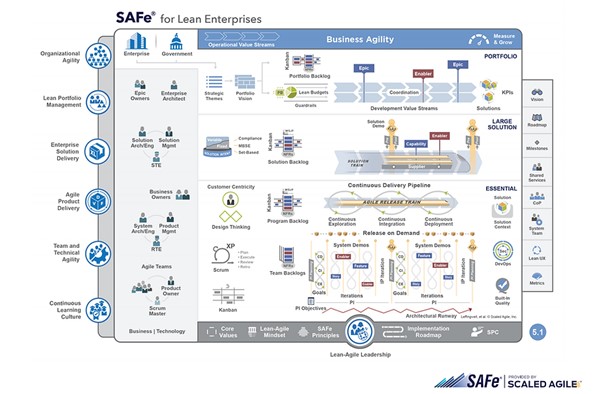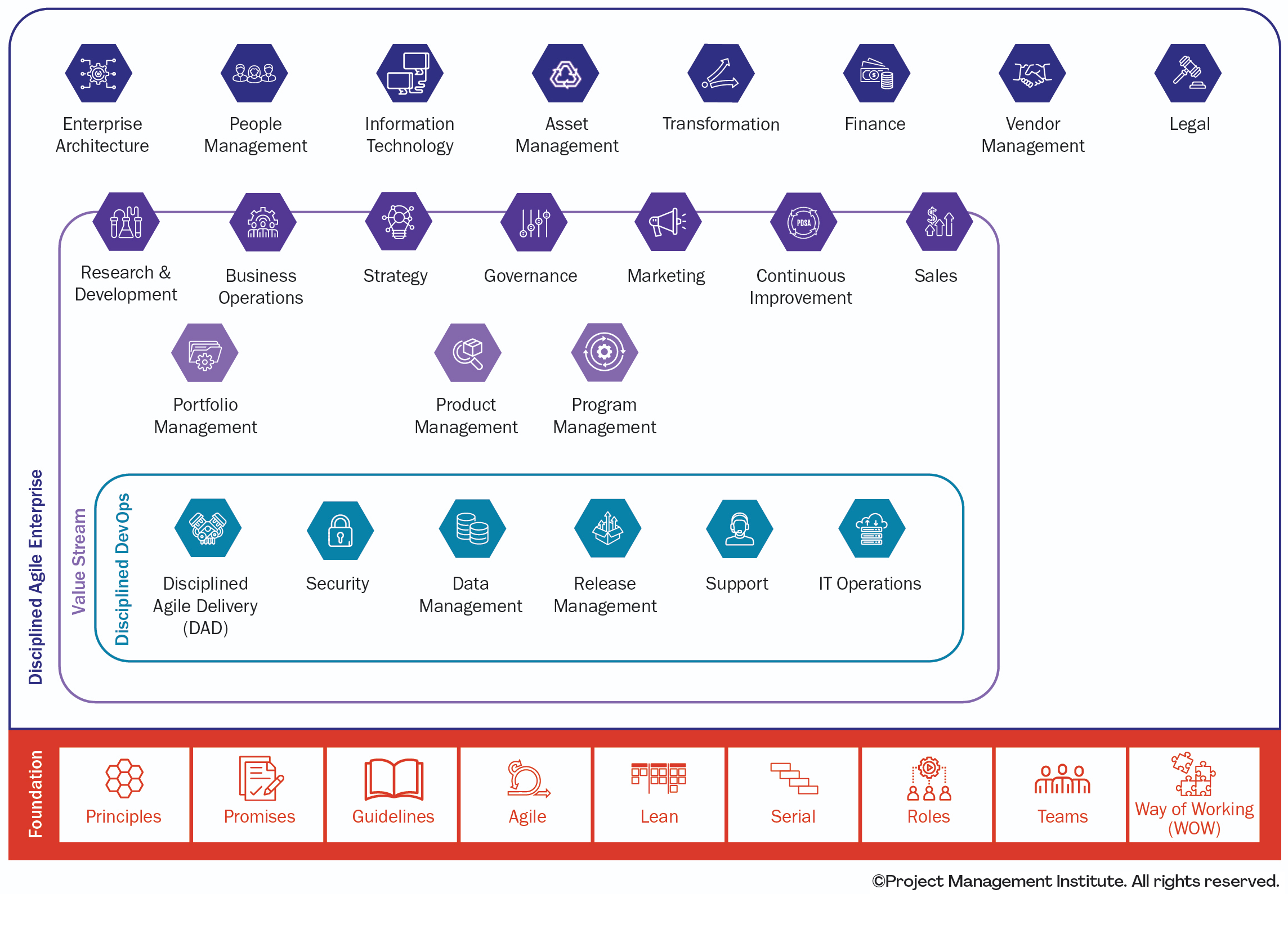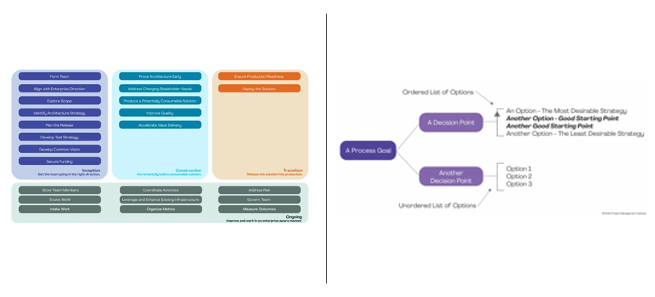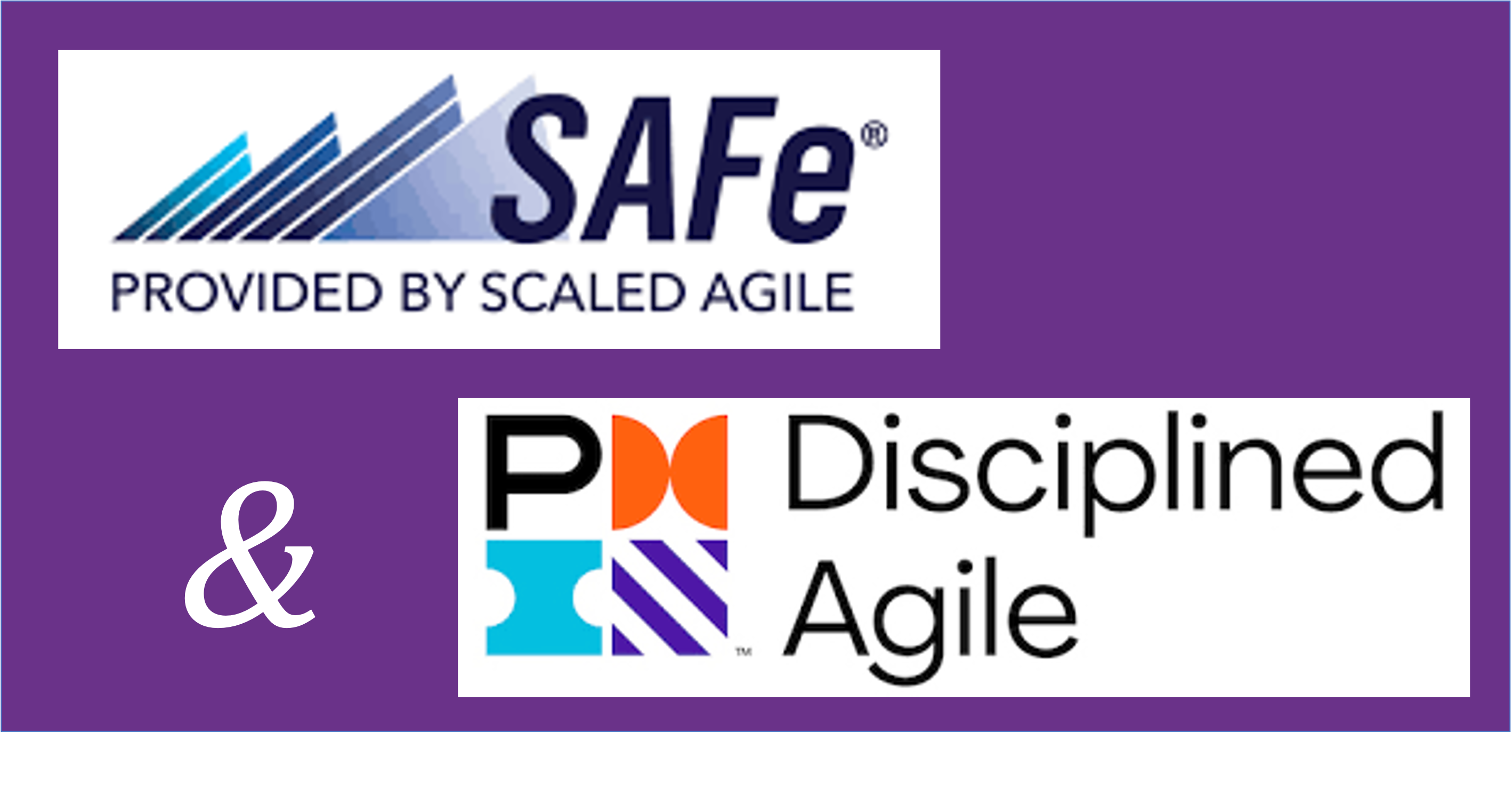Disciplined Agile® (DA) and the Scaled Agile Framework (SAFe®) are two popular, second-generation agile methodologies. They build on lean-agile thinking; and standard Scrum, Kanban, and DevOps practices. They offer practitioners tools to extend and mature their agility beyond the team to programs and the broader enterprise.
They emerged about a decade after the Agile Manifesto. DA was developed in 2011 by Scott Ambler and Mark Lines and is based on Scott’s work at Rational Software and IBM. The Project Management Institute acquired DA in 2019 to extend its agile capabilities. Dean Leffingwell released the first version of SAFe in 2012. Interestingly, Dean also worked at Rational.
SAFe and DA are often misunderstood within the agile community. They are criticized as being “heavyweight” or “too complicated.” Since I hold advanced certifications in both frameworks and regularly teach agile classes, I have a unique perspective and appreciate what they offer.
Both refer to themselves as “frameworks” or “toolkits” rather than methodologies. This is a nuanced yet critical distinction. They provide guidance and structure rather than expect rigid adherence. They are comprehensive—with hundreds of pages of detailed documentation—to support teams addressing complex problems.
The Big Pictures
The frameworks are designed to foster business agility. Each has a “big picture” (see: DA, SAFe) describing its components with links to detailed knowledge articles. They are “open source,” with all the information publicly available. To understand how they work, I recommend learning from a qualified instructor who will guide the learning experience and provide valuable context.
SAFe offers four configurations, from Essential to Full. Most organizations start with Essential, which describes how to lead an agile program, or Agile Release Train (ART). Full SAFe extends the framework to Large Solutions that require coordinating many ARTs and implementing Lean Portfolio Management.
Essential SAFe is the core configuration and is designed for managing a program of 5-12 agile teams. To coordinate the teams, SAFe applies cadence and synchronization. Cadence means all teams are aligned to a standard, two-week delivery cycle. Synchronization is achieved through a quarterly 2-day, “big-room planning” event. While DA also has a program lifecycle, it is less comprehensive than SAFe.

Disciplined Agile is methodology agnostic and supports Scrum, Kanban, Program, and continuous delivery lifecycles. DA defines “process blades” to describe common enterprise capabilities. These blades can be “configured” to help organizations adopt an agile “way of working” (WoW).
Disciplined DevOps is the set of process blades enabling the continuous delivery of working software. The next layer is the Value Stream which incorporates components for creating products and services that delight our customers. Finally, the outer layer extends to enterprise functions such as Legal, Finance, and HR.

The core of Disciplined Agile is its toolkit of process goals, decisions, and options. Two-dozen process goals describe the major development steps from inception to construction and transition, as well as the ongoing efforts to mature the team. Each goal is deconstructed into multiple decision points with a prioritized list of options and trade-offs. The goal map is an invaluable, curated list of the tacit knowledge retained by experienced project managers.

Using the Frameworks
SAFe and DA are optimized for large organizations maturing or building their agile practices. Organizations starting their agile journey may be overwhelmed by the frameworks and under-appreciate the depth of their guidance.
DA takes a pragmatic approach to agile adoption with the mantra, “Start where you are, do the best that you can given the situation you face, and always strive to get better.” It believes context counts, teams should make pragmatic decisions based on well-considered choices.
The first step is selecting a development lifecycle that best fits the project. Next, teams evaluate their environment and make some process decisions. The goal chart helps identify their current state and options for better fitting or more mature practices. The DA Browser is an online tool enabling this exploration.
SAFe delivers agile at scale using a holistic approach. It recognizes that an agile transformation is a significant organizational change in addition to adopting new practices. SAFe includes a 12-step implementation roadmap built on John Kotter’s 8-step model for leading change. Implementing SAFe begins with training the change agents and executives in the lean-agile mindset and SAFe practices. Without strong leadership support and commitment, change efforts fail.
The Agile Release Train (a SAFe program) is the cornerstone of SAFe. It is a virtual team of 75-125 people aligned to support a value stream. The entire ART operates on a common 2-week cadence and begins its 10-week Program Increment (PI) with a 2-day planning event. The PI includes four 2-week development iterations and 2-weeks for Innovation & Planning (IP). The IP iteration provides a buffer, allowing the teams to complete unfinished work, prepare for the release, plan for the following PI, and improve.
A release train engineer, product manager, and systems engineer lead the ART. This configuration creates a balance of power. The release train engineer serves as the scrum master for the program. The product manager sets the strategic direction, maintains the program backlog, and coordinates the efforts of the team-level product owners.
The 2-day PI Planning event includes everyone—business owners, the entire development team, and support teams. The desired outcomes are identifying the objectives that drive the next quarter’s work and coordinating the ART activities. The event facilitates quick resolution of interdependencies, risks, and issues.
SAFe and DA are independent frameworks built on shared values that can coexist within an enterprise. However, it is uncommon to see teams using both frameworks simultaneously. DA’s process choices can inform and guide continuous improvement even for teams practicing SAFe. And, SAFe can provide additional structure for enterprises needing to coordinate the work of multiple agile teams.
Certifications
DA and SAFe have a series of certifications that generally require attending a 2-day class and passing an exam. The exams are challenging and require study. They are closed book, online, and self-proctored. The course fee includes one attempt at the exam with an additional fee for retakes.
Most people start their SAFe journey with the Leading SAFe class, which introduces foundational concepts and practices. Leading SAFe reviews agile concepts but assumes a working knowledge of Scrum and Kanban. SAFe offers additional role-based courses for scrum masters, product owners, architects, etc. Advanced certifications are available for Program Consultants, Trainers, and Portfolio Managers.
The Disciplined Agile Scrum Master (DASM) is a comprehensive entry-level certification covering Scrum, Kanban, and the DA toolkit. No agile experience is required, but it would be helpful. The Senior Scrum Master (DASSM) is the second-tier certification and requires 2-years of experience and knowledge of DA. DA also offers advanced Coach and Value Stream Consultant certifications.
© 2022, Alan Zucker; Project Management Essentials, LLC
See related articles:
- Business Agility: Getting Started
- Disciplined Agile: To Agility and Beyond
- Going Agile
- PMI Goes Agile
- Making Sense of Agile and DevOps
- Scrum vs. Kanban: What to Choose?
To learn more about our training and consulting services or subscribe to our newsletter, visit our website: https://pmessentials.us/.

